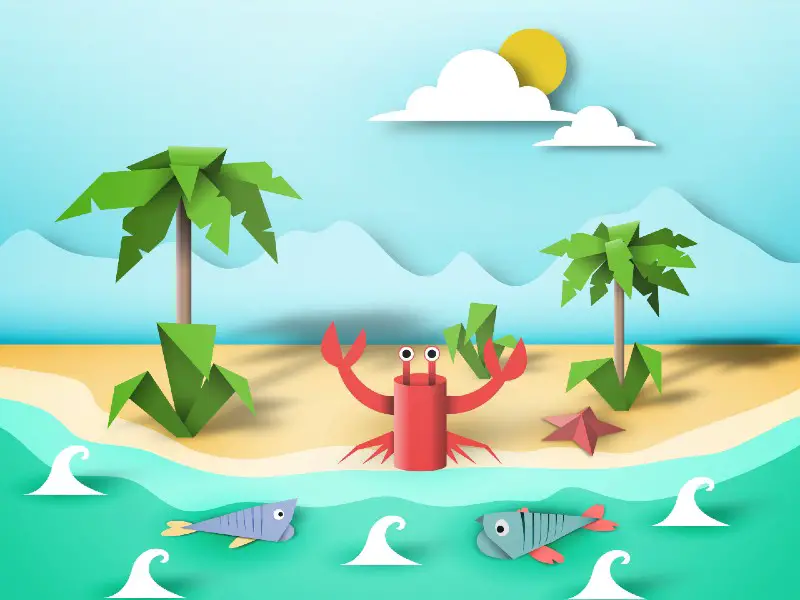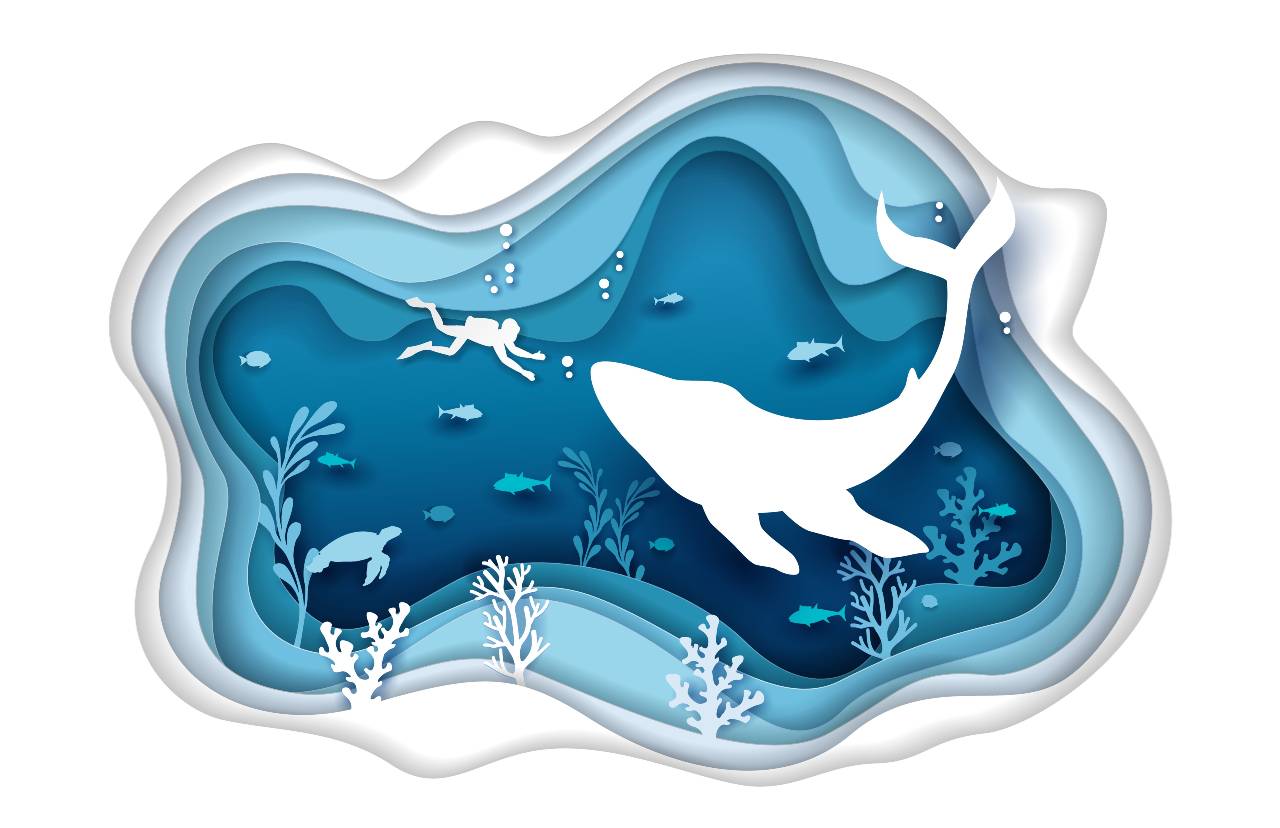There are all sorts of amazing ocean crafts for preschool children, and whether you want to create jellyfish, pufferfish, whole ocean floors, or any other sea-themed art project, there are plenty of options that are perfect to get little children engaged with the underwater world.
Paper Plate Puffer Fish
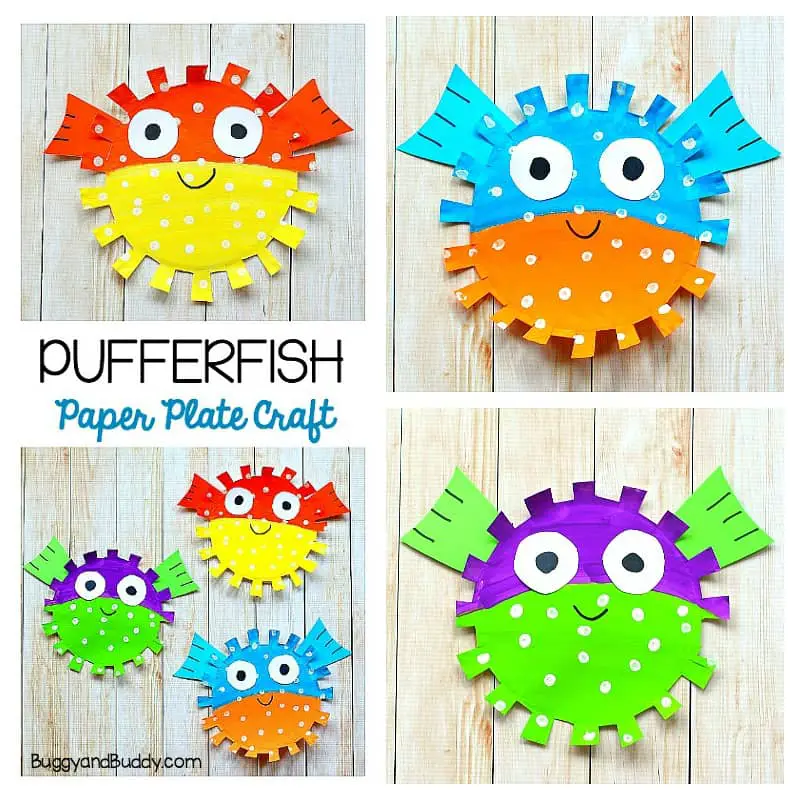 Source: https://buggyandbuddy.com/paper-plate-pufferfish/Paper plates are ideal for a whole range of crafts, and they are absolutely perfect for a paper plate pufferfish. You can create many different designs and styles here using the basic pattern, so no matter what colors your child wants to use, they have options.
Source: https://buggyandbuddy.com/paper-plate-pufferfish/Paper plates are ideal for a whole range of crafts, and they are absolutely perfect for a paper plate pufferfish. You can create many different designs and styles here using the basic pattern, so no matter what colors your child wants to use, they have options.
Materials
A paper plate pufferfish requires:
- 1 paper plate
- 2-3 different paint colors
- Paintbrush
- Black marker pen
- White paper
- White glue
- Scissors
- Pencil
- 1Card in a color to suit your paint colors
Step 1: Cut Around The Paper Plate
It may be easiest to do this yourself, or help your child and make sure they don’t cut themselves with the scissors.You are going to go all around the edge of the paper plate, cutting small rectangles out to create an effect like the top of a castle wall. These don’t need to be particularly neat: just make an overall square-in-square-out effect around the whole plate.
Step 2: Paint The Plate
Next, you can pour out some paint for your child to paint with. They may want to paint the two halves of the plate in different colors or experiment with stripes or spots. It doesn’t matter what colors the pufferfish ends up, as long as they have fun!
Step 3: Cut And Stick The Fins
Your pufferfish needs some extra fins, so draw some slightly tapered rectangles on your colored card, and then help your child to cut around these. They should be stuck to the back of the paper plate, so they want to be quite long, allowing them to stick out past the plate’s edges.Stick them so that they fan out on either side of the puffer fish’s head.
Step 4: Cut Out The Eyes
Help your child cut two large white circles, and then use the marker to add pupils to them. Glue these in the upper half of the puffer fish’s body, and draw a little smile beneath them.
Step 5: Add Final Details
Your child can now use pens or another paint color to add any final details, such as spots or spirals, to further decorate the pufferfish. Once they are happy, set the pufferfish aside to dry. It can also be hung up by a thread if you like.
Chalk Jellyfish
 Source: https://www.projectswithkids.com/chalk-pastel-jellyfish-art-project/If you want a simple, minimal mess and low-supervision craft, a chalk jellyfish can be a great one.
Source: https://www.projectswithkids.com/chalk-pastel-jellyfish-art-project/If you want a simple, minimal mess and low-supervision craft, a chalk jellyfish can be a great one.
Materials
For this craft, you’ll need to gather up:
- A large sheet of black paper or card
- Plenty of chalks
- Spray varnish
Step 1: Draw The Jellyfish Body
Your child should start by drawing a jellyfish body near the top of the paper. This wants to be fairly oval, with a wavy bottom. They can choose any color they like, though light colors will show up better on the black background.Once they are happy with the body’s shape, they can color it in fully, or just shade parts of it to add a sense of depth and color.
Step 2: Add The Tentacles
Next, the jellyfish needs a good forest of tentacles. Encourage your child to use a variety of colors and different thicknesses. They may also want to add some lines of dots to indicate tentacles that are further back.The tentacles can again be colored or left unfilled.
Step 3: Draw Some Bubbles
Part of what makes this art striking is the light colors against the background, so your child probably doesn’t want to cover too much of the black up, but a few little bubbles rising through the water will give the jellyfish some context and make the picture look finished.Bubbles can be drawn in all different sizes, and should just have a few curves of chalk to indicate the shine of light within the bubble. Don’t worry too much though; as long as your child is having fun, it doesn’t matter if the bubbles aren’t super realistic.
Step 4: Varnish The Picture
Once your child is satisfied with the picture, you should use some spray-on varnish to fix the chalk, or you’ll find it comes off and smudges every time the picture gets touched.Spray the varnish in a very ventilated space and let it dry before you closing windows, etc. Don’t spray it with your child nearby.Once the varnish has dried, they can hang the picture up in their bedroom or on the fridge.
Sea Floor Sculpture
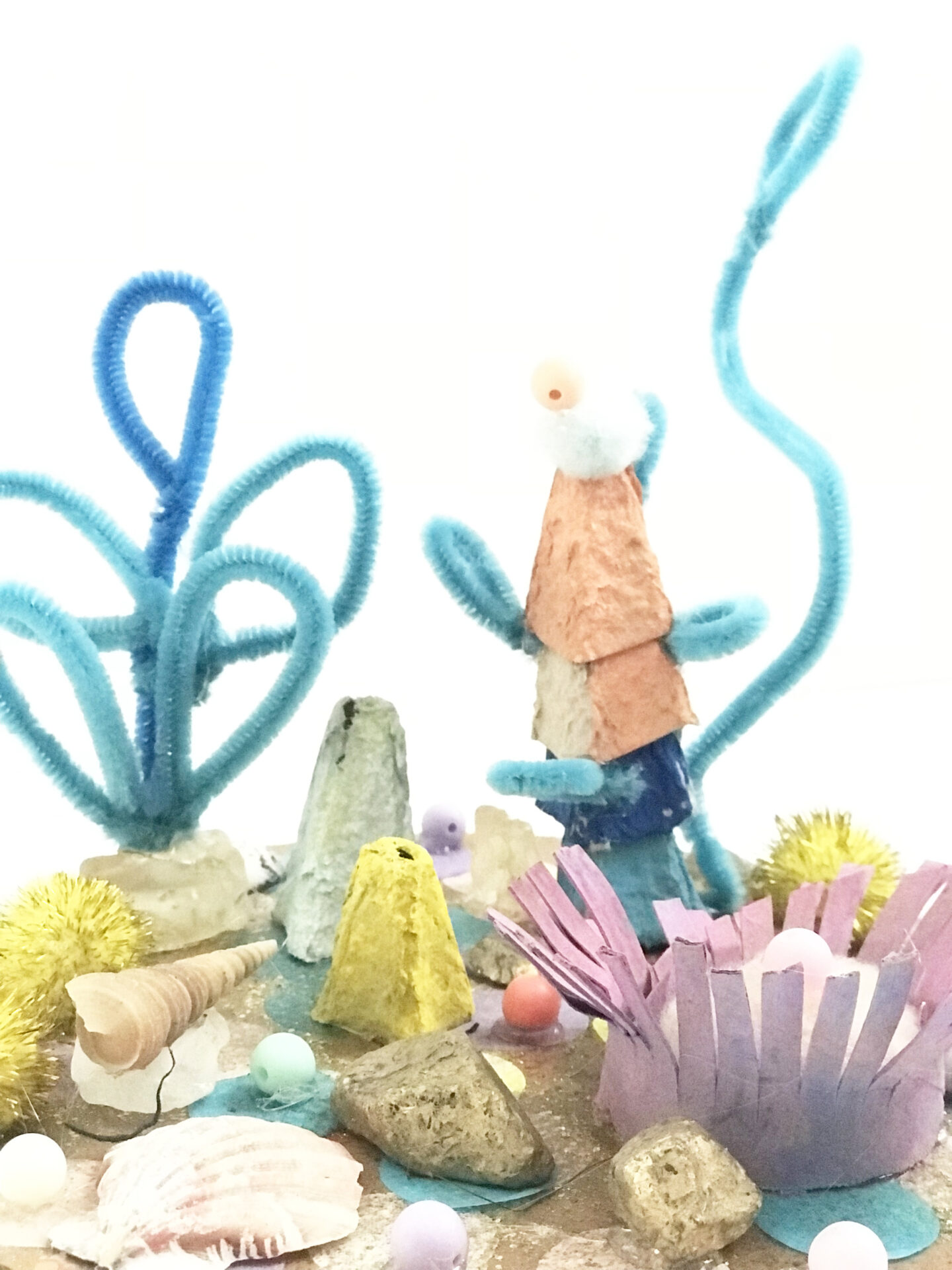 You can create a really beautiful bit of sea art using an old (preferably large) cotton bud container or any other totally clear container that has a lid. This can be quite an involved piece of art, or you can keep it fairly simple.
You can create a really beautiful bit of sea art using an old (preferably large) cotton bud container or any other totally clear container that has a lid. This can be quite an involved piece of art, or you can keep it fairly simple.
Materials
You’re going to need:
- Yellow card
- Some small pebbles
- Green tissue paper
- Colored card (of any colors)
- Shiny card
- Glue
- Scissors
- A pencil
- A sprinkle of sand (optional)
- Clear fishing wire
- Superglue
Step 1: Cut Your Base
First, you’re going to help your preschooler cut a base for the container. Draw around the container on the yellow card, and then cut this out. You may need to trim it down slightly. Check that it will fit into your container. Tip it back out so you can decorate it.Help your child add some dabs of glue and sprinkle the sand on (if you’re using it) to make the base pretty.
Step 2: Twist Up Some Seaweed
Get your child to tear off some thin strips of the green tissue, and then twist this up into seaweed. A dab of glue on your sandy floor, and you can help them glue the seaweed into a little clump.
Step 3: Add The Stones
If you can find any tiny pebbles, add them to the base. If you can’t, don’t worry too much; you can either use some rolled-up scraps of paper or just leave the base sandy.
Step 4: Make Some Fish
Help your preschooler cut some little fish out of the colored and shiny card. These should be quite small, and they don’t need to be very neat. If you don’t have a shiny card, use a little bit of aluminum foil instead. Shiny fish will look great in the shoal as they will catch the light nicely.
Step 5: Glue The Fishing Line To The Lid
Cut several small lengths of your clear line and then use the superglue to attach these to the lid of the container, so that they hang down into the main compartment. Be very careful not to let little fingers near the superglue; put it away as soon as you have finished with this step.
Step 7: Glue The Fish On
Use white glue and help your child glue the fish to the dangling lines. This will suspend them beautifully in your little tank. They can be glued at different heights, or in color clusters to create shoals. Cut off any excess fishing wire to make it look tidy.Once the fish are stuck in place, put the lid on the container and admire your amazing ocean scene!
Step 8: Add More Details (Optional)
If you have space (this will depend on container size) and you’re feeling inspired, you can keep adding to your ocean scene. Ideas for other things include a little red crab, or perhaps a treasure chest. Both of these can easily be made from cardboard, though they may prove a bit too complicated for your preschooler unless they are really keen.
Tropical Reef Egg Carton
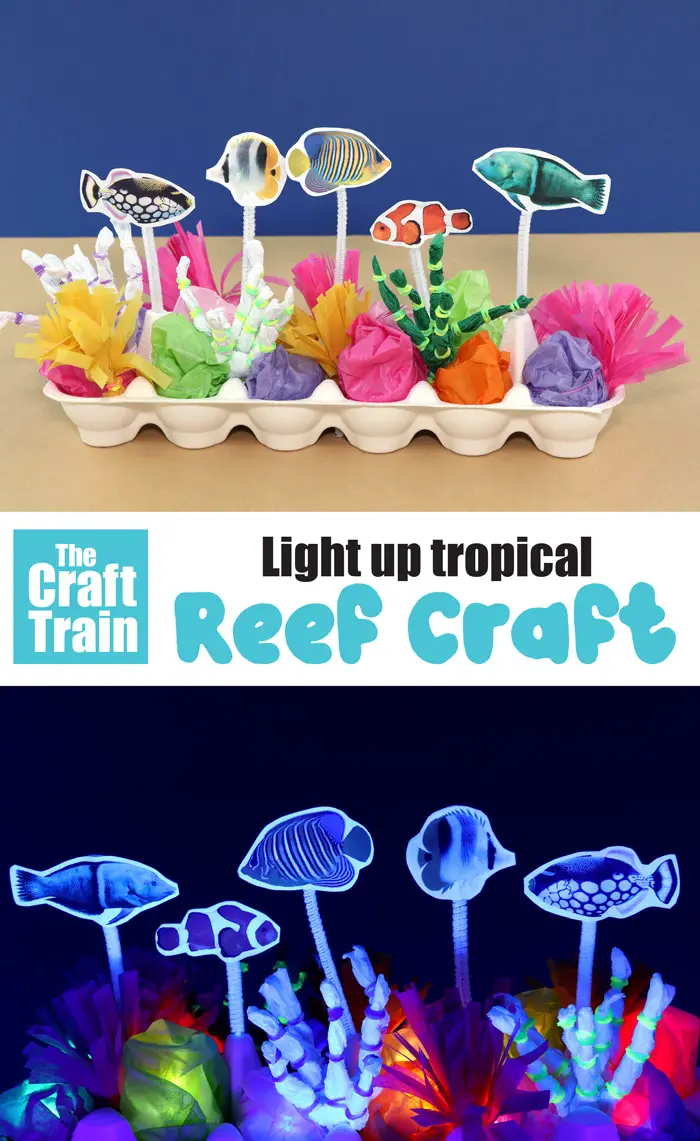 Source: https://www.thecrafttrain.com/light-up-reef-craft/?utm_medium=social&utm_source=pinterest&utm_campaign=tailwind_tribes&utm_content=tribes&utm_term=1101615042_51205822_132164You can create an amazing tropical reef with very few materials, and your preschooler will love learning about the different kinds of fish. This is also a great opportunity to explain a bit more about coral and how important reefs are to the planet.
Source: https://www.thecrafttrain.com/light-up-reef-craft/?utm_medium=social&utm_source=pinterest&utm_campaign=tailwind_tribes&utm_content=tribes&utm_term=1101615042_51205822_132164You can create an amazing tropical reef with very few materials, and your preschooler will love learning about the different kinds of fish. This is also a great opportunity to explain a bit more about coral and how important reefs are to the planet.
Materials
An egg carton reef needs:
- An egg carton
- White glue
- Colorful tissue paper in reds, oranges, greens, etc.
- Toothpicks
- Scissors
- Loom bands
- Fish printouts
- White card
Step 1: Print Out The Fish
Find some brightly colored fish online and let your preschooler choose some to print out. Cut them out and stick them to the white card, and then cut them out again. This will make them sturdier.If you have time, it’s best to print a reverse image for each fish so that you can make your reef double-sided. Don’t worry if you would rather not do this, though; it’s good to keep crafts simple for little ones so they don’t lose interest.
Step 2: Cut Your Egg Carton
You only need half of the egg carton that contains the cups; you can cut off and discard the other half (or let your preschooler tear it off).
Step 3: Fill In The Reef
Help your child tear the tissue into pieces, and twist and tuck it into the cups. Use glue to secure it, and spend a bit of time helping your child model it into interesting shapes. You can cut long fronds or fans, twist, and spiral bits, or squash nodules down to make sponges. You might want to look at some reef pictures for inspiration.
Step 4: Keep Adding Detail
Take some longer strips of tissue and roll them up into tentacle-like tubes. You can decorate these with a few stripes using a neon gel pen, or help your toddler put loom bands around them for a bit of color.Bend and wriggle them around, and then glue them in patches to the carton, like reaching worms.
Step 5: Glue The Fish On
Glue each of the fish printouts to a toothpick, and then glue each toothpick to the egg carton. This will suspend the fish above the reef so they look like they are swimming in and out of the coral. Try to get them at different heights and angles.
Step 6: Add Details (Optional)
Once the fish has dried, get your preschooler to think about what else they would like to add to the reef. You could include some little stones, or perhaps a fake pearl or two hiding in among the tissue. Also consider some green tissue seaweed, as mentioned in the last project. Alternatively, consider cutting a small starfish out of an orange card, or see if you can find some tiny shells to add to the edges.It doesn’t matter too much if this is realistic to an actual reef; just let them have fun.
Conclusion
You should now have some amazing ideas for ocean crafts you can try with your preschoolers. These offer you great opportunities to talk about the underwater world and the different creatures that might be found there.
Comments
0 comments

